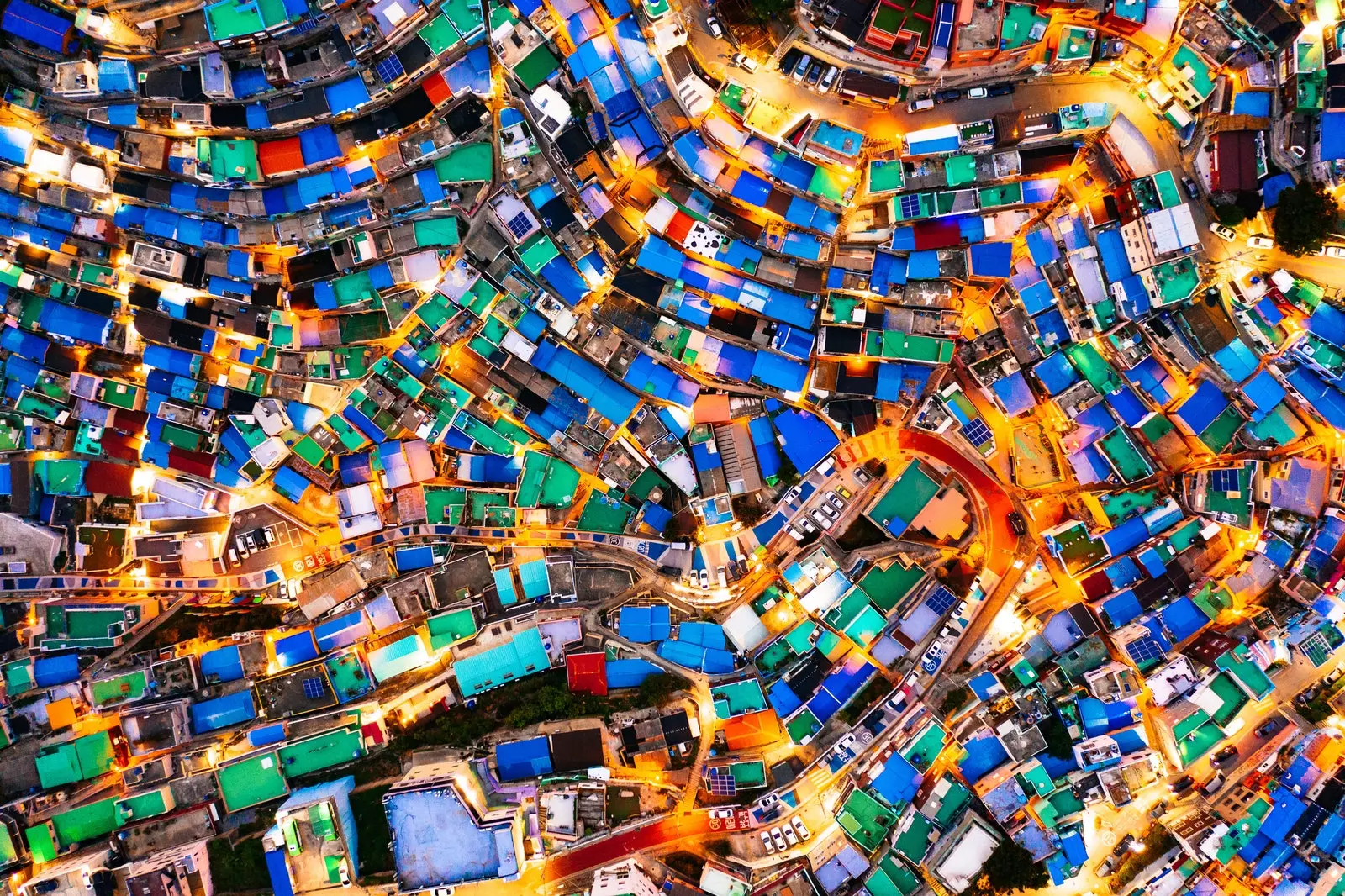
That's how colorful and artsy Koreatown is at Gamcheon Culture Village.
View from a distance, Gamcheon, the most picturesque village in unknown Busan, second largest city in South Korea, it can remind you of any suburb of the Latin American capital. Scattered to the sea by Bandal Hill, its colorful and small houses mark the character of this atypical neighborhood where art arrived ten years ago determined to establish itself, become strong and finally dominate the space.
The journey between pink, yellow and orange facades; brown, green and blue roofs, and an infinite number of artistic demonstrations, starts at the last stop of the shuttle bus that connects the Goejeong subway station with Gamcheon-dong.
But the first thing, before even starting this peculiar artistic adventure, is get an illustrated map in the Information Center, an accessory essential if you want to be able to find most of the creations. Next to the booth, a viewpoint welcomes and shows newcomers the most typical picture: that of the hundreds of colored houses that occupy so many Korean postcards.
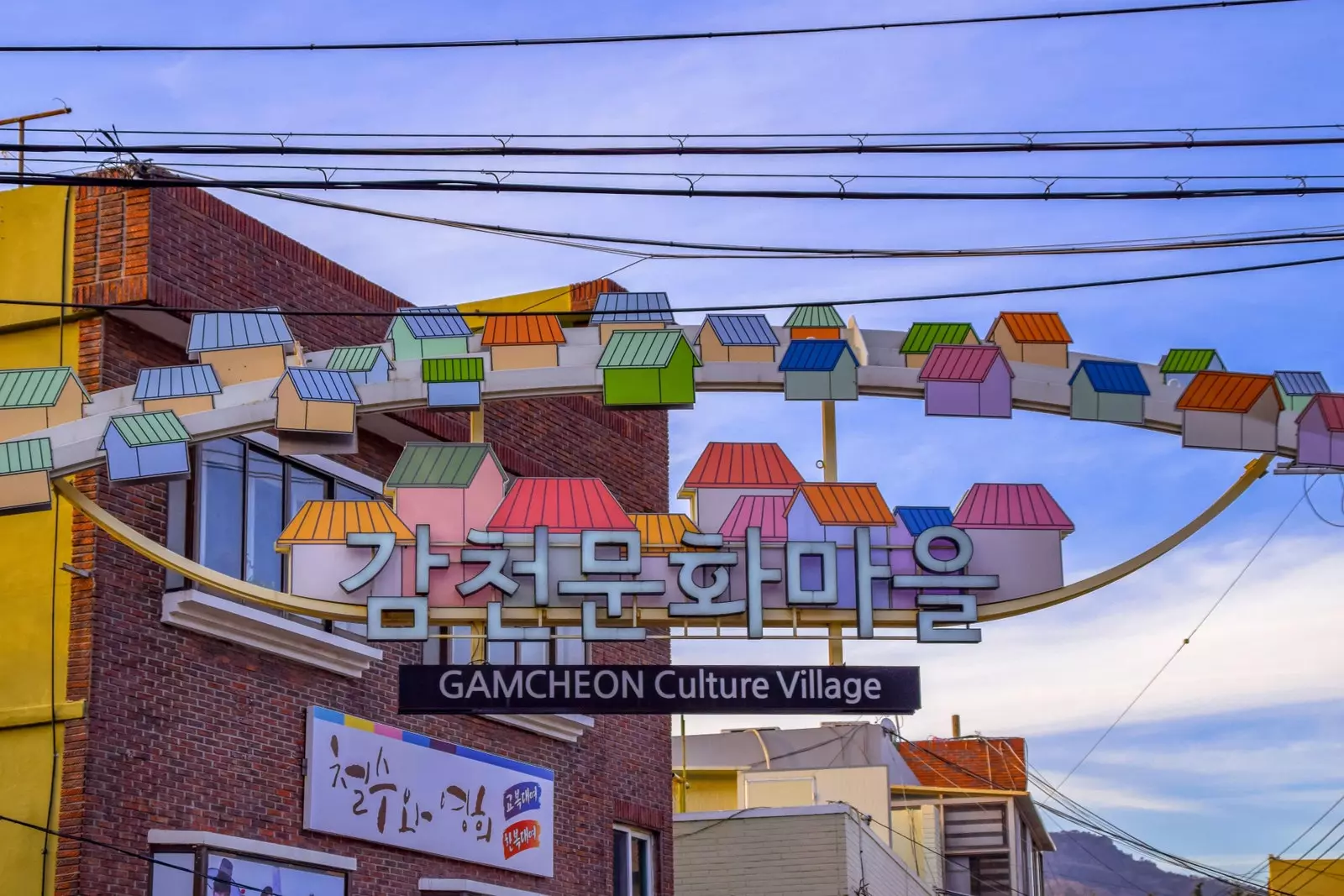
Gamcheon is the most picturesque village in Busan, the second largest city in South Korea.
ART PACKING
A stuffed cat perched on the tiles of a neighboring house warns of what is to come: More than 100 art installations scattered throughout the most unlikely corners of Gamcheon Cultural Village They wait to be discovered, photographed, and incidentally, give a little life to the networks with the most instagrammable material.
However, the village was not always as it appears today. His past is presented a few meters from the arch that, with huge letters, marks the access: in the Small Museum of Gamcheon. With a facade decorated with murals that show the image of their houses today, inside there are several exhibition rooms in which, with old photographs and objects from other times donated by the neighbors themselves, its origin is narrated .
Roots that go back to the middle of the 20th century, when the Korean War broke out and a large number of refugees decided to come to this corner in search of peace and security. Busan was the only conflict-free space in the country, what better place than this? After the war, and while the rest of the city began in the race to reach infinity with its skyscrapers, Gamcheon was kept in its original state, with houses built from wood and iron. and a rather less developed environment. Something that remained despite the years.
Today, the main street of Gamcheon Culture Village is lined with all kinds of tourist businesses. The cute rooftop cafes with views for icy milkshakes they alternate with noodle restaurants, original souvenir shops, art galleries, stalls selling delicious Ssiat Hotteok (pancakes made with brown sugar, cinnamon and typical Busan nuts)… and even a curious shop specializing in postcards and stamps with images inspired by Gamcheon and made by local artists.
The music of the trendy K-pop group emerges from any street-facing speaker alongside the groups of young people dressed in the typical hanboks (traditional Korean costumes) they strive to photograph themselves in each of the corners. The tourists on duty, meanwhile, get carried away by the unstoppable wave of stimuli at every step.
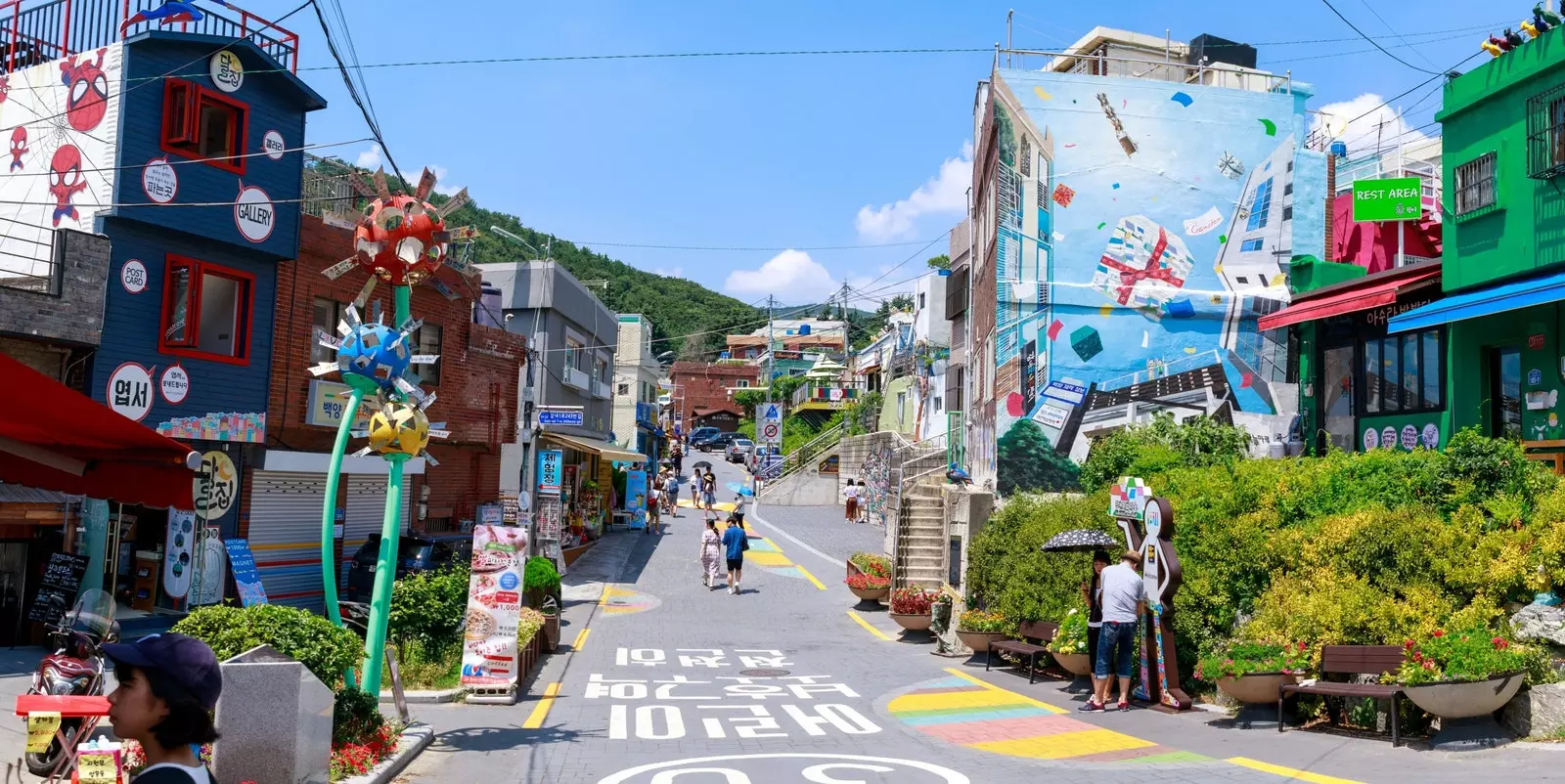
One of the streets of Gamcheon Culture Village, South Korea.
THE MOST IMPORTANT WORKS
And the art continues. All over. Looking up—always look up in Gamcheon— A handful of smiling ceramic birds with human heads perched on the roof of the Mira Mira cafeteria. It is Jeon Yeongjin's People and Birds, that tries to transmit that desire that the human being can sometimes feel to fly and thus forget the most mundane problems.
Gifts from the Sky, Na Inju, is a huge mural that occupies the entire facade of a neighboring building. Nearby, one of the star works: the Jin Yeongseop's Fish Swimming through the Alley, a huge fish made from small pieces of wood placed on the wall that tries to define the alleys of Gamcheon as communication spaces for the villagers.
And yes: Gamcheon does not belong only to the hundreds of tourists who until now visited the village daily. Gamcheon is also one of its neighbors, who behind the colored walls of their houses, continue to make life as best they can. It was not easy for them to accept this project with which the Ministry of Culture appeared in their homes back in 2009 with the intention of reactivating the village and turn it into the "Machu Picchu of Korea". Despite initial misgivings, and although the project obviously has nothing to do with Machu Picchu, today they approve it with satisfaction.
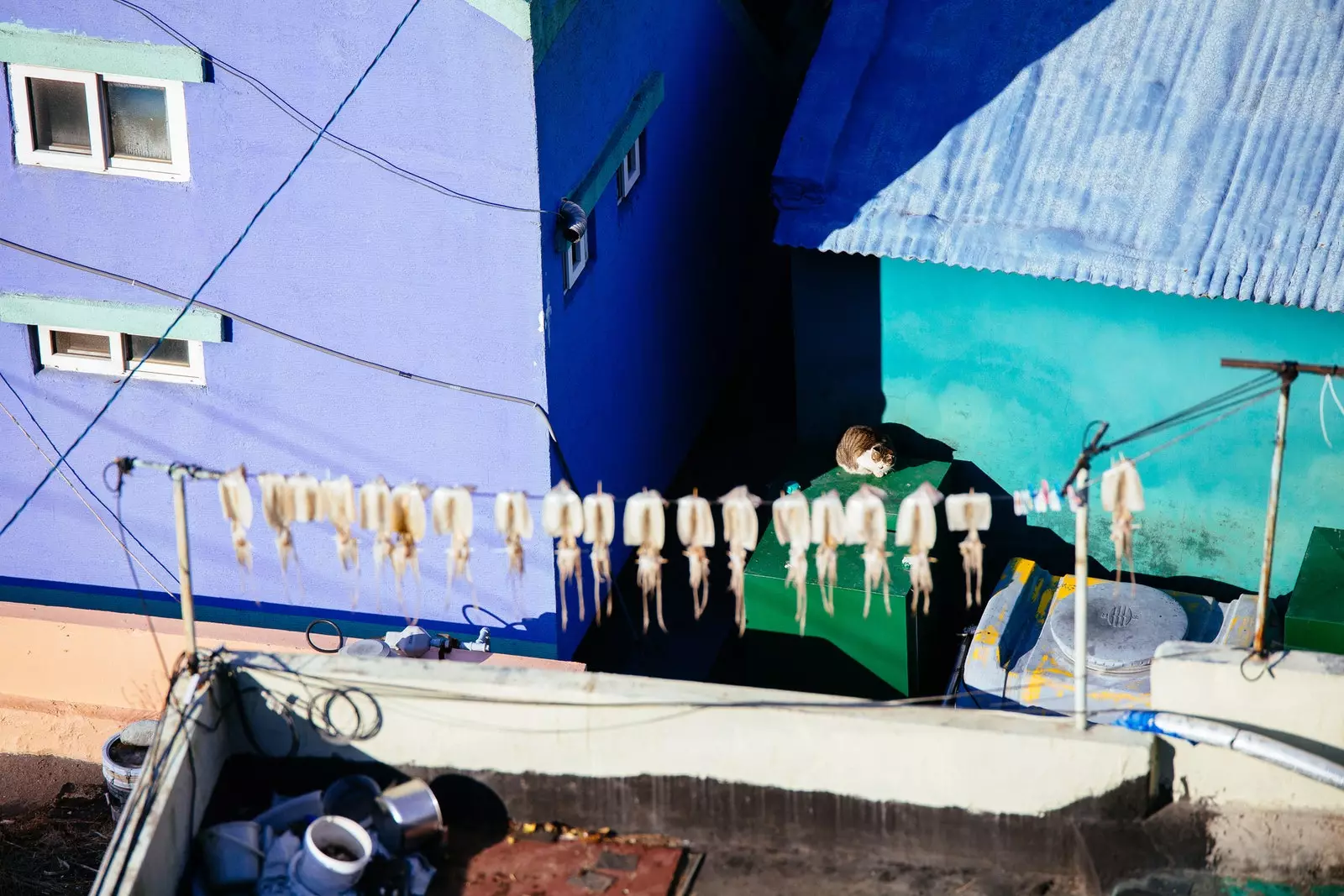
Squid drying in the sun on a terrace at Gamcheon Culture Village.
Just have to deviate from the main streets and browse through the narrow alleyways to continue finding art, yes, but combined with hanging clothes that reveal that life hidden behind its first layer. Next to the sheets and socks attached to strings, cuttlefish and algae also rest, drying in the sun. that give stamps of the most particular. A symbol at the entrance to one of the houses reveals that there are no neighbors inside, but rather an artistic installation. Modern Man, where several pairs of hands type endlessly on an imaginary computer, it puts the focus on the repetitive life that many people lead today.
A sign politely asks that the tone of voice remain restrained when visiting the neighborhood while the smell of home cooking escapes through the occasional window. Also family conversations. We even come across an inhabitant who is encouraged to climb the steep stairs loaded with the purchase of the week.
Stairs that, of course, also have their artistic side: the calls 148 Stairs lead, according to a sign, to see the stars. And maybe not the stars, but what they do reveal are a handful of drawings of everyday scenes captured on their steps. at the top, a workshop: the House of Star Stairway, where you are invited to take pop painting and plaster classes hand in hand with one of the neighbors responsible for the Artist in Residence project. This is just one of the many initiatives in which the inhabitants themselves participate to convert their living space into their workplace as well. Classes in fabric dyeing, stamp design or pottery are other offerings.
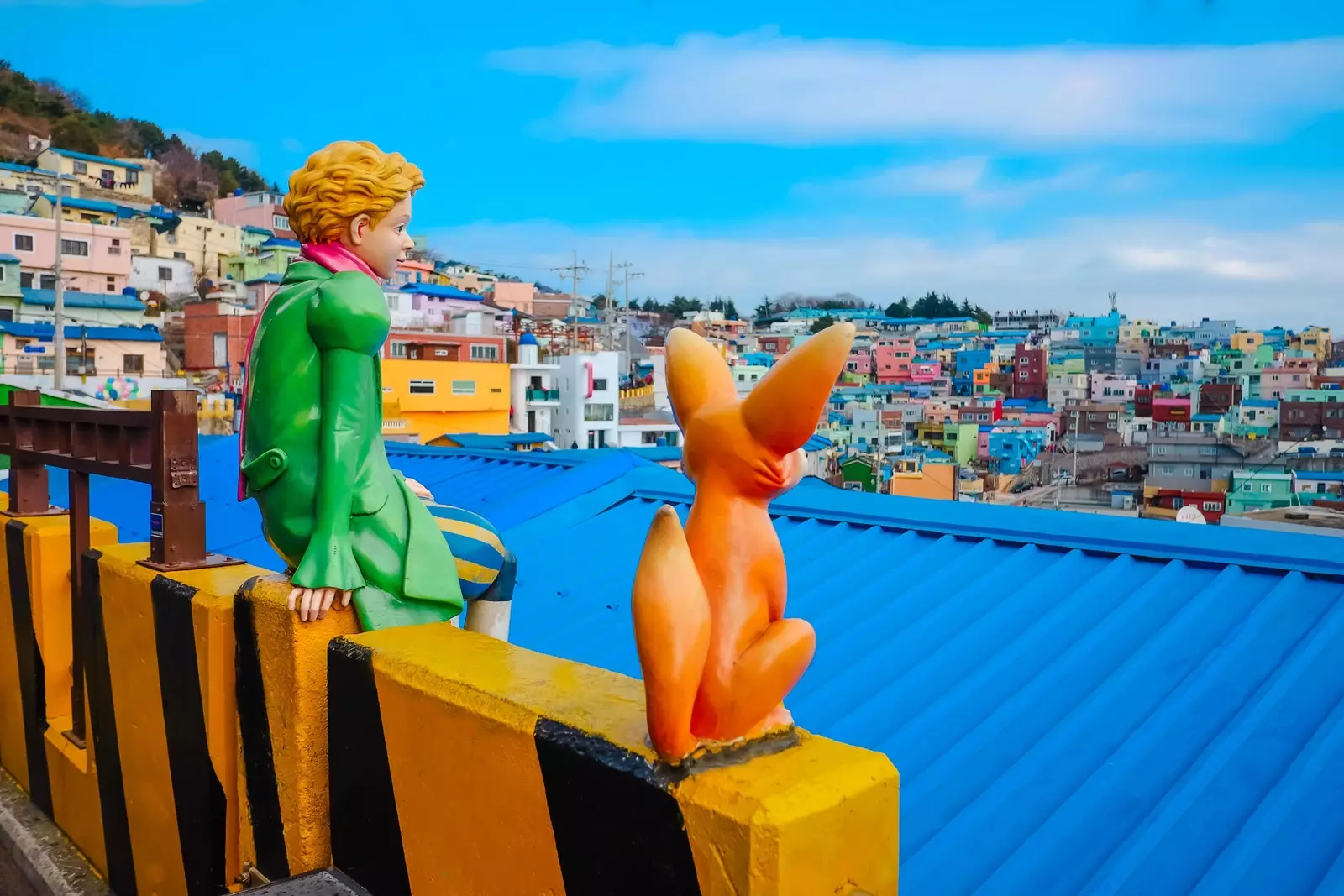
The Little Prince and the fox, sitting on a gazebo overlooking the sea of colored houses.
THE WORKSHOPS
The best thing is that through these workshops —also with the sale of maps and with the various businesses open in the village— It manages to raise money to improve the living conditions of many of the villagers. And they do it either by repairing the houses of those who cannot afford to pay for the works; with the construction of a community bathroom —many households still do not have their own—, or through a free laundry service for the elderly. **A task that reflects the collaboration between residents, artists and local authorities. **
And while everyday life unfolds, Gamcheon Culture Village continues to amaze like a fantasy world. It is easy to come across the Little Prince and the fox, sitting oblivious to everything in a gazebo overlooking the sea of colored houses, while a handful of tourists line up to be photographed next to him. The miniature model of Lee Ghangwoon or the surreal sculpture of King Jongsun alternate with the fun life-size figures of people who, in any park or corner, recreate scenes of daily life, becoming inseparable companions on the route.
Where least expected, a lighthouse-shaped house appears, painted with black spots like a dairy cow, or built of wood under the design of a renowned Korean architect: Seung Hyo-sang. The art does not stop; the desire to discover it, either.
But as the sun dips over the horizon and businesses begin to close, the visitors disappear, and Gamcheon recaptures the essence of the village it always was. a place where everyday life lays down on its cords again, cooks again in their homes, and transforms into stray cats again in search of the remains accumulated in any garbage.
Although, yes, the smiling colored birds, those who watched perched on the buildings, will not move. They must ensure that when a new day begins, the new reality continues its course.
